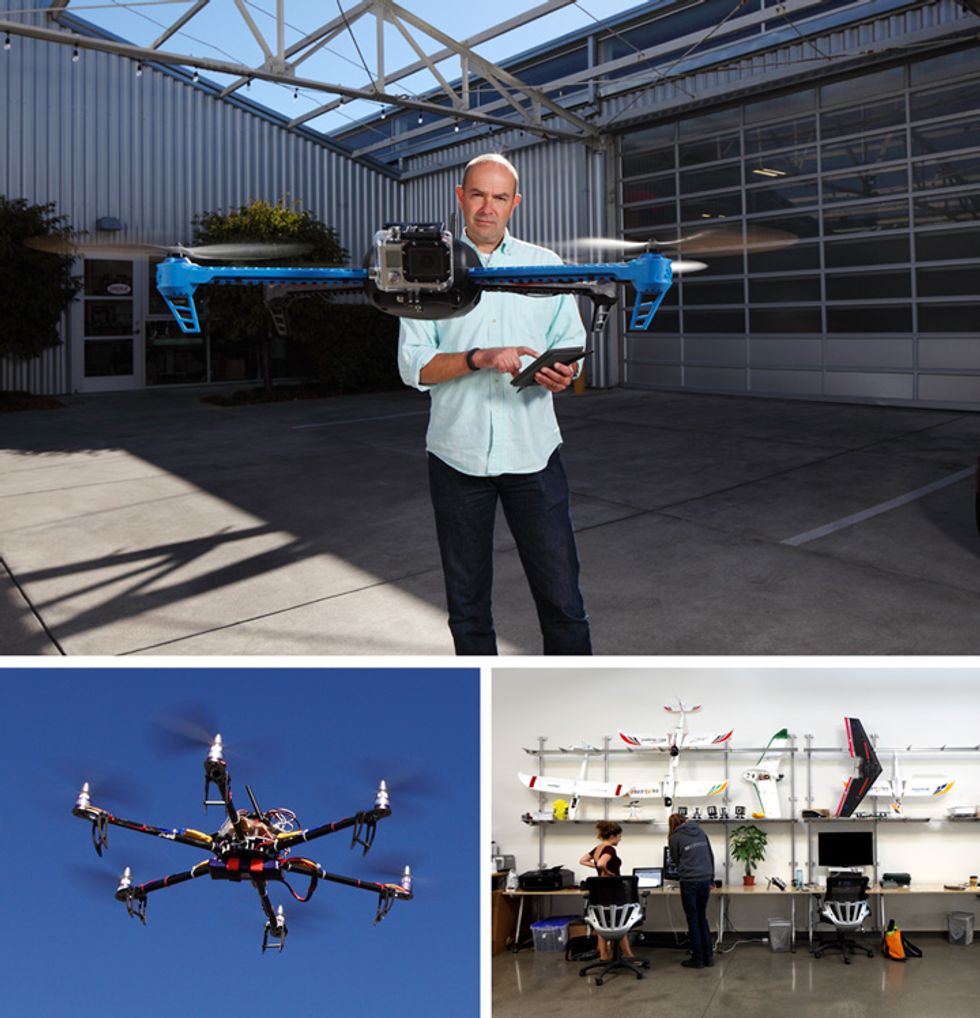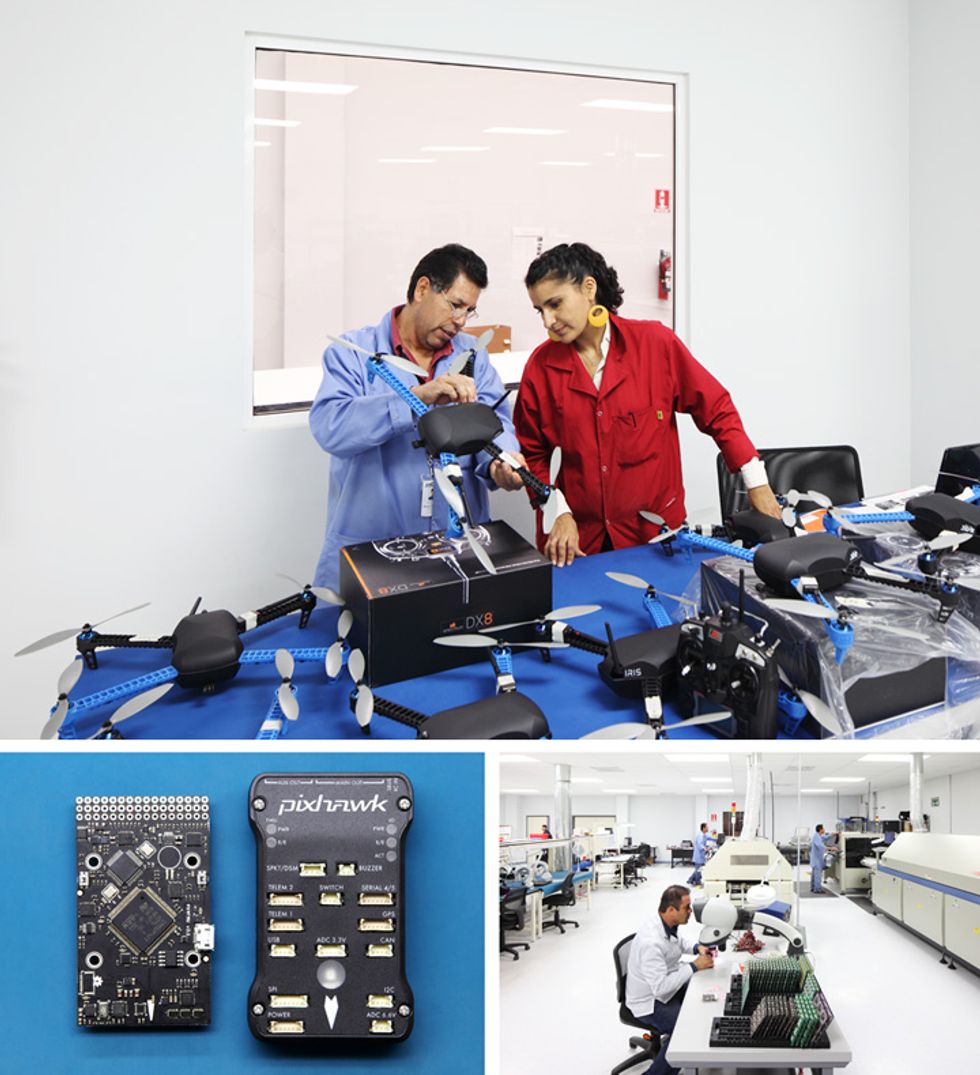Chris Anderson’s Expanding Drone Empire
At the former Wired editor’s start-up, 3D Robotics, open-source robots take to the skies
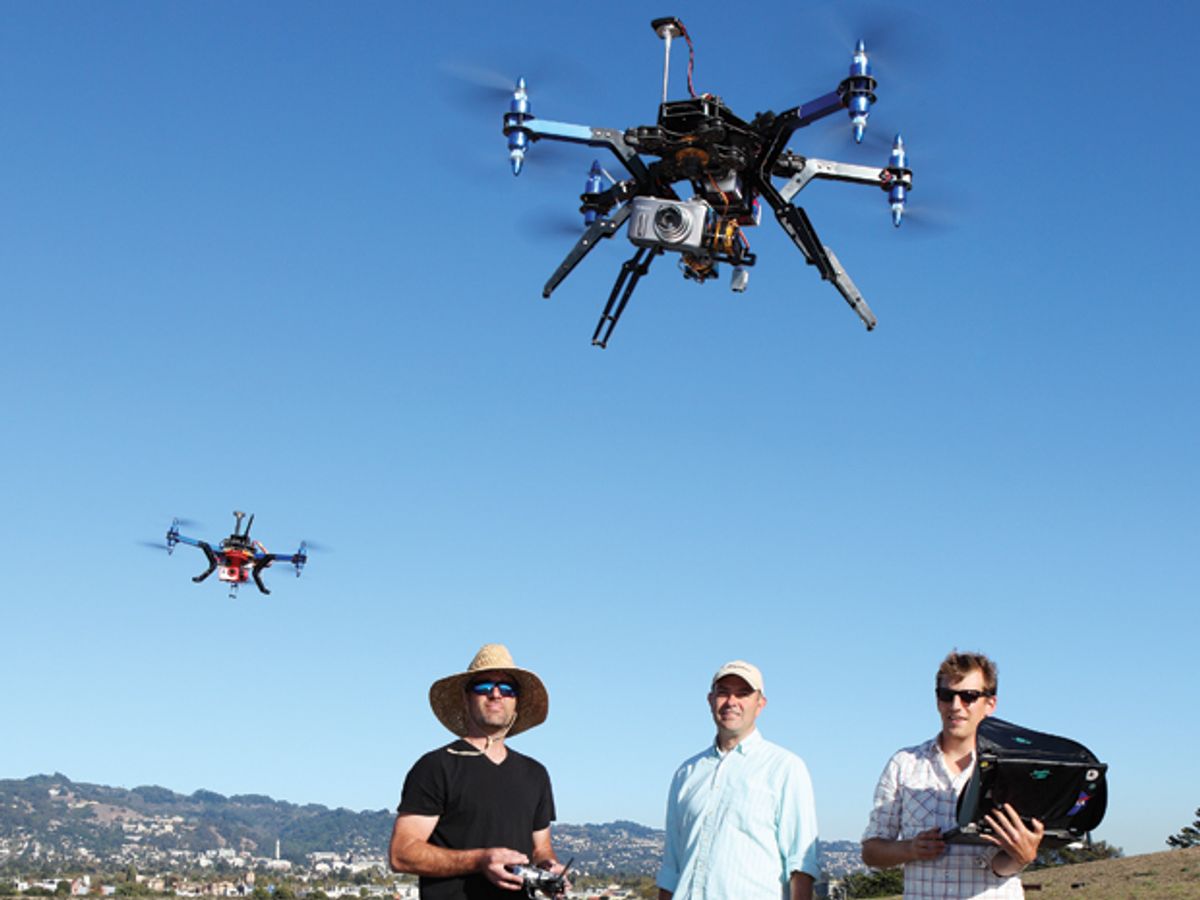
Friday is Fly Day at 3D Robotics, a maker of small robotic aircraft. So here we are, on a windswept, grassy landfill with a spectacular view of San Francisco’s Golden Gate Bridge, looking up at a six-prop copter with a gleaming metal frame. It’s like a spiffy toy from the future. Buzzing like a swarm of bees, it lifts off smartly, hovers, then pinwheels.
“Jason’s making the hex twirl,” says CEO Chris Anderson, a trim man in jeans and an untucked oxford shirt. “That’s just for show—a human pilot couldn’t do that.” That’s because Jason, the flight tester, did nothing more than figuratively push a button. The hexarotor—technically, the 3DR Y-6—is on autopilot, which it demonstrates by zooming off on a preprogrammed route. The Y-6 sells for US $619. That’s a lot for a toy, but it’s chicken feed for a capital investment.
These mini unmanned aerial vehicles, a.k.a. UAVs, a.k.a. drones—are changing from toys into tools, as businesses worldwide awaken to their importance. It’s happening fast: Twenty thousand of these inanimate insects will be skittering through U.S. skies by decade’s end, according to the Federal Aviation Administration. That’s provided the FAA soon issues regulations for their commercial use, a job it was supposed to have completed long ago.
“At first, investors thought drones were not a market,” Anderson says. “Then, around nine months ago, they realized they were one. Now the question is, will we be the leader?”
In late September, just the day before this Fly Day, in fact, Anderson’s company got $30 million from venture capitalists. That second round of funding came on top of $6 million raised a year earlier and will help 3D Robotics gear up for the commercial market that the FAA is preparing to allow.
And while his company bulks up, Anderson hopes that its roots in the amateur, DIY community will keep it close enough to the market to let it fend off the big boys—companies like FedEx, Germany’s DHL delivery service, Domino’s Pizza, and Amazon. All have recently chosen to talk up their own drone projects.
In November, Amazon’s CEO, Jeff Bezos, got one of the biggest free advertisements in high-tech history by telling a television reporter that his company was working on copters to deliver small packages to customers’ doorsteps. Bezos’s scheme was basically preposterous, but that interview, and the accompanying video clip showing a pre-enactment of such a delivery, reverberated wildly. Which was, of course, the point.
Just a month earlier, Anderson had told IEEE Spectrum that using drones to deliver pizza was so much pie in the sky. “Anything that involves flying over people is going to be difficult,” he said. “It’s more than just the FAA here; it’s a question of privacy.”
Now, though, he diplomatically declines to beat up on tech honchos with blue-sky visions. “Bezos and others articulate a vision in the hope of encouraging it to happen,” he says. “They’re doing a proof of concept to show that the technology lies in reach, that it’s worth considering. Worth beginning the regulatory discourse.”
Anderson’s flair for talking the talk of business shows how far he’s come from his days as editor of Wired magazine. His self-reinvention began in the aughts, when he built a drone with his kids for fun. In 2007 he turned his new hobby into a Web-based community called DIYdrones.com. Then, in 2009, he cofounded 3D Robotics, helping it grow until at last he had to choose between it and his day job. Now he’s the former editor of Wired.
If he speaks more frankly than other UAV entrepreneurs, though, it’s only partly a vestige of his newshound roots. At least as important is his business model, which relies on both open-source hardware and software and thus laughs at secrecy. 3D Robotics patents nothing; it collaborates on everything, mainly through the DIY-drones community.
In 2011, when a graduate student in China translated a manual for a 3D Robotics UAV to help people who bought a Chinese version of the machine, Anderson says he was “angry—at first. But then I realized it was helping us. Our policy of open software and open hardware almost welcomes copycats.” So he put a link to the translation on his site.
This approach is new, Anderson says. “Open hardware, drones, and the future of robotics; merging the [hobbyist] community and the company. If we get it right, it’ll be a fantastic model for companies of all sorts; if we get it wrong, an instructive failure.”
Hobbyists show off solutions to their own problems and get others to suggest improvements. Such helpers get to bask in the glow of 3D Robotics at an annual shindig in Colorado. Those who offer particularly valuable help get a 3D Robotics mug. A fortunate few—very few—actually get hired.
The poster child for that elite is Jordi Muñoz. He broke off his studies in electrical engineering in Mexico to spend two years on drone technology, cranking out C++ code for a UAV autopilot based on the Arduino microcontroller. Anderson heard of the autopilot, ordered a test version, and began an online dialogue that ended with the two men’s founding of 3D Robotics. (The name refers to the one dimension where robots had not previously gone: up.)
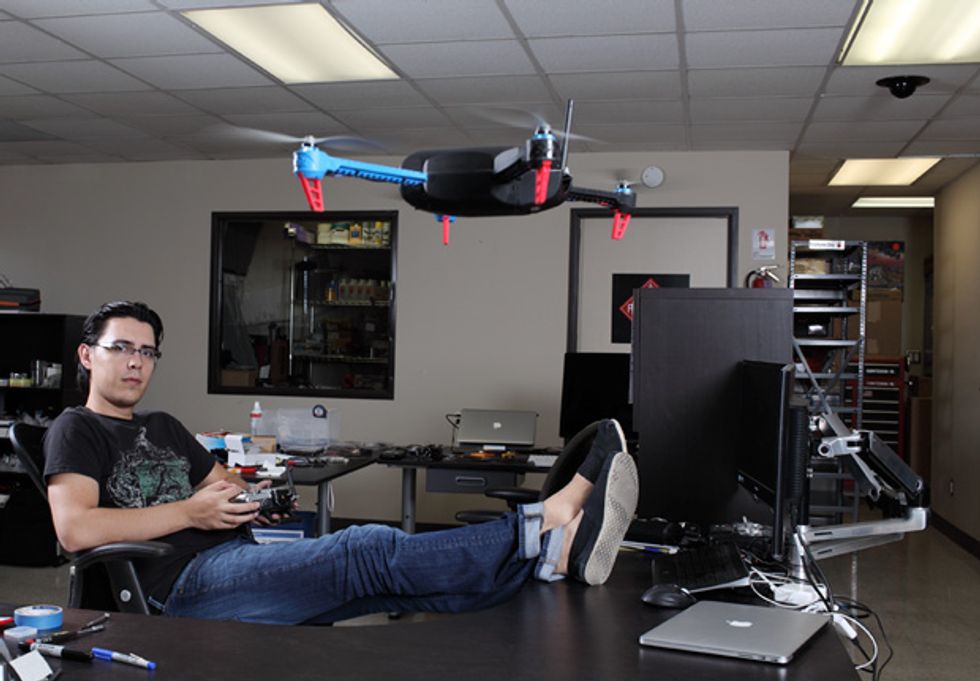
“He mentored me on business, finance, legal, and P.R. matters,” says Muñoz, now 26. “He also sent me some money.” Muñoz moved the short (yet very long) distance from Tijuana, Mexico, to San Diego, Calif., to build the company’s R&D office. Anderson stayed in Berkeley, Calif. When demand got big enough, they started up a factory in Tijuana; it recently added a second shift. Soon it may add a third.
Anderson won’t give actual sales figures, but on another day, in San Diego, Muñoz lets a few numbers slip. The biggest seller is the autopilot circuit board: “Three hundred units a month; our ready-to-fly is at about 3000 a year,” Muñoz says. Not bad for a business with a lot of upside.
What Anderson will say is that 3D Robotics has doubled its sales every year and should keep on doing so, and that it is now second in size only to DJI Innovations, in Shenzeng, China. That company’s Phantom quadcopter competes directly against 3D Robotics’ Iris. “It’s not autonomous,” Anderson sniffs. “It hovers, but it can’t follow way stations,” as Iris does.
Following way stations is what you’d want to do to survey the corners of, say, a farmer’s field. And yes, agriculture is the first big business that Anderson expects to open up. There are already thousands of UAVs zooming around in military applications, of course. But Anderson isn’t after that market. “Our developers are doing it for civilian use, and they’ve spoken loud and clear: They don’t want their code to be weaponized,” he says. Plus, selling to the military brings an array of often surreal challenges, he points out.
So, agriculture. Farms are far from the city’s madding crowds and so offer safe flying areas; also, the trend toward precision agriculture demands aerial monitoring of crops. Like traffic watching, it’s a job tailor-made for a robot: dull, dirty, and dangerous.
Ben Gielow, the general counsel for the Association for Unmanned Vehicle Systems International (AUVSI), figures that of the early commercial adopters “80 percent will be in agriculture, 10 percent in public safety, and 10 percent is everything else—mapping, say, or wildlife conservation.” (Another of Anderson’s targets is Hollywood, which uses copters for unorthodox camera angles.)
Farming apps for drones also have the advantage of already being legal, or at least it would seem so. When Spectrum asked the FAA’s lawyers to comment, they replied: “Farmers may operate an unmanned aircraft over their own property for personal use and should operate safely so as to minimize risk to other aircraft or people or property on the ground.” And they should be sure to wear sunscreen, too.
“I use it to manage our vineyards,” says Ryan Kunde, a fifth-generation winemaker in Sebastapol, Calif., who uses a fixed-wing UAV fitted with one of 3D Robotics’ Arduino autopilots. “We gather imagery from a bird’s-eye view to see the variability and to change farming practices to reduce that variability.” He says he has a company in the works that will sell aerial-monitoring services to other farmers as soon as the FAA says it can.
Farmers are also prime customers because they need a lot of customization—a key element in 3D Robotics’ business model. Quadcopters, which are highly maneuverable, are needed if trees present obstacles to straightaway flight, Kunde says. Infrared cameras come in handy at “bud break” time, in the spring. “You’ll have areas that ‘push’ earlier than others,” he says. “If you could image that in a heat map of the vineyard, it would be cool to see the variation.”
Anderson emphasizes customization to play up his community’s edge in crowdsourced solutions to problems. He sells several different rotorcraft and a fixed-wing plane, but he refers to them all as platforms. “You need a platform to be truly disruptive,” Anderson says. “We’re the Android of UAVs.”
Take the gimbal, a camera-stabilizing device that typically has three degrees of freedom. Type in the keyword “gimbal” on the DIYDrone.com message board and you’ll bring up thousands of comments, many including videos. Fiddling with these gizmos is a community effort, though often mediated by 3D Robotics’ staffers.
Most of the company’s copters are quads or hexes, which can carry up to twice as many propellers as they have arms by mounting counter-rotating pairs. Coaxial props provide useful redundancy; extra arms (as in the hex) provide greater stability. A doubled-up Y-6 known as the Beast has 12 motors and props. It can easily lift 2 kilograms. “Unfortunately, it’s not for sale, because there’s not much demand,” says Justin Cunningham, a flight-test engineer in the San Diego office.
Problem is, these copters can stay up for only 10 minutes or so, 20 at most. That’s okay for gentlemen farmers with tiny spreads, but others would opt instead for the company’s fixed-wing platform, the 3DR ATF APM:Plane. Stripped down, it sells for $570, though as with the rotorcraft, the customer can pile on avionics, multiple radio receivers and antennas, cameras, and on and on.
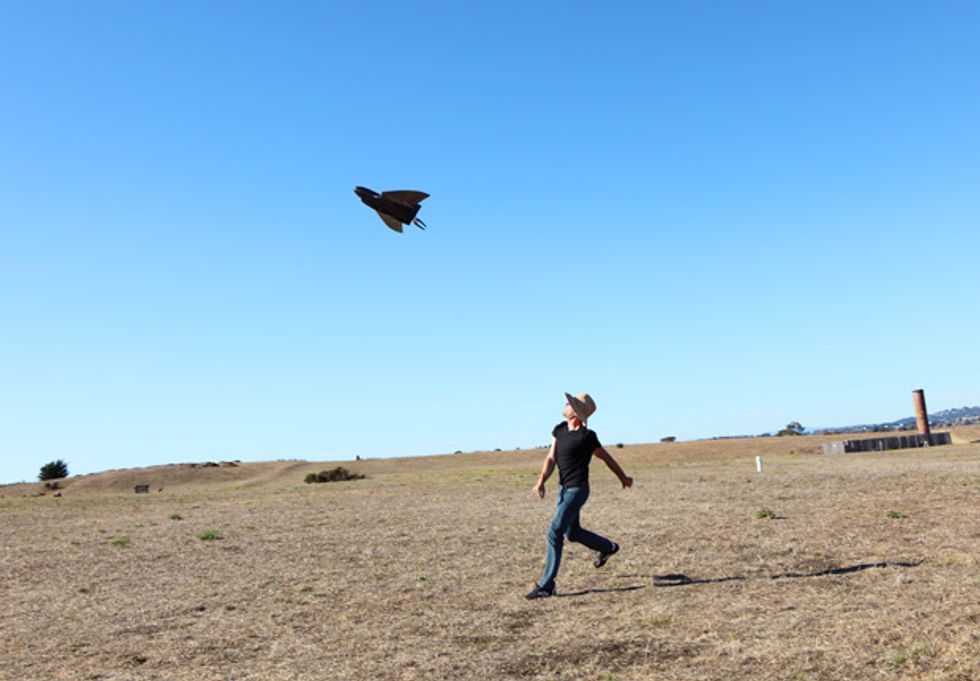
On Fly Day, the dozen-odd staffers in Berkeley are auditioning a possible successor to the plane. They call it the Dark Knight, because it’s as black as Batman’s cape. Jason holds it at the end of a straining bungee cord and then lets go, slinging the plane straight into a brisk bay breeze. The plane rises to about 20 meters and flies at 15 knots, “maybe 30, with the wind,” says Jason. But the plane struggles to gain and keep altitude; the lithium-polymer battery’s a little spent.
If the truth be told, these batteries are anemic even when they’re fully charged. Energy storage remains the industry bugbear. You can solve that problem by going big and ditching batteries for internal combustion engines. For 27 years, Japanese farmers have dusted their crops with Yamaha’s RMAX robotic helicopter, a table-size robot with a two-stroke engine that lets it stay aloft for hours. “Japan’s aviation authority didn’t regulate it; their department of agriculture promoted it,” says AUVSI’s Gielow.
Another engine-powered drone, Boeing’s ScanEagle, embarked last summer on the first FAA-approved commercial mission beyond the line of sight of its operator, ConocoPhilips. The reason for the approval? The plane flew over Arctic waters, looking for icebergs, whales, and other potential visitors to offshore drilling platforms. A crash, presumably, would bother nobody but the fishes.
Larger craft may not fare well under the FAA’s rule, at least not anytime soon. As pilots say, when something goes wrong, it can ruin your whole day. In September, a New York City man was killed by his own Trex 700N, a 3-kilogram helicopter powered by an internal-combustion engine. Even small copters can be dangerous if they put all their power into just a single large blade.
3D Robotics multicopters’ smaller blades are far more innocuous, and its fixed-wing plane carries its prop in the back, so it can’t give anybody anything worse than a nasty bump. What’s more, all its platforms run on electricity.
But that leaves the question of how to keep them up longer—and it’s a big one, says Muñoz. There are many possibilities, he says, and all are on the table. You could minimize friction with a slower-spinning motor. Or you could supplement batteries with little fuel cells, “methanol—1 volt, which means 12 cells, but really, really small ones. Or you could even use a wire tether,” he says.
Another challenge is quality control. As aviation regulators prepare for the industry’s breakout to commercial users, even minor defects will have to end. At the 3D Robotics factory in Tijuana, East Asian quality-control protocols are being worked out, including scanner-readable tags on every item.
Guillermo Romero, the general manager, points out a fenced-in area that has been set aside to test every single ready-to-fly UAV before it gets shipped. Most defects, he says, are cosmetic, but even major problems are usually easy to repair. “We are moving from a 70 percent yield [before testing] to 80 percent; our goal is 97 percent,” he says. The next step is to track every item with machine-readable tags.
Manufacturing began in a corner of Romero’s Tijuana apartment, moved to a nearby space of 250 square meters, and moved again in the middle of 2013 to the present 1100-square-meter building. Assembly was mostly by hand; now it’s mostly by machine.
To make GPS modules, for instance, an array of circuit boards goes in a pick-and-place machine called a Manncorp MC386. In parallel movements that handle several boards, suction devices pick an element—a resistor, say—off a paper reel, put it where it’s supposed to go, then perform another such operation. When all the slots are full, the boards go in an oven that heats them in a time-varying pattern that ensures that the different solders, on the different elements, melt at once and uniformly.
Romero holds up a matchbox-like autopilot. “Here’s an ArduPilotMega, Jordi’s thing,” he says. “It’s why we are all here.”
That autopilot’s packed with goodies. “Gyroscopes, accelerometers, a compass—you need that too, because you’re not always moving!” Muñoz says. And he and his band of researchers are working on add-on hardware to make UAVs more aware of their surroundings. “You can always add more—a laser sensor’s superaccurate, helps you avoid obstacles.”
Avoiding obstacles, known in the trade as sense-and-avoid capability, is what UAVs need to achieve. Until then, they’re shackled by safety regulations that require line-of-sight operation far from schools, pets, and angry birds. Obstacle avoidance is harder than you’d probably guess from those Internet videos showing UAVS zipping through slots in a wall and performing other acrobatic feats (as Spectrum’s Evan Ackerman calls it).
Those videos were taken in labs, with objects placed just where the UAV expects them to be, with robust full-motion tracking managed by external sensors and superfast wireless networks. Even very large drones have only recently managed to do anything like that in the wild.
Then again, only recently have we gotten used to walking around with smartphones in our pockets. And, as Anderson emphasizes, the smartphone is exactly the right analogy, more so than even the Pentagon’s Predator drones. It was the smartphone market that spawned affordable GPS, fast local networking, and instant video, capabilities that today’s mini UAVs depend on. When a UAV commercial market emerges, it too will plant the seeds of many other industries.
“What moves the needle is when hundreds of thousands use drones every day, for buzzing over crops or taking pictures of action sports,” Anderson says. “The vast majority of amateurs do it because it pushes their emotional and intellectual buttons. Employees do what I tell them to; volunteers do what they want.”
This article originally appeared in print as “Open-Source Drones for Fun and Profit.”
